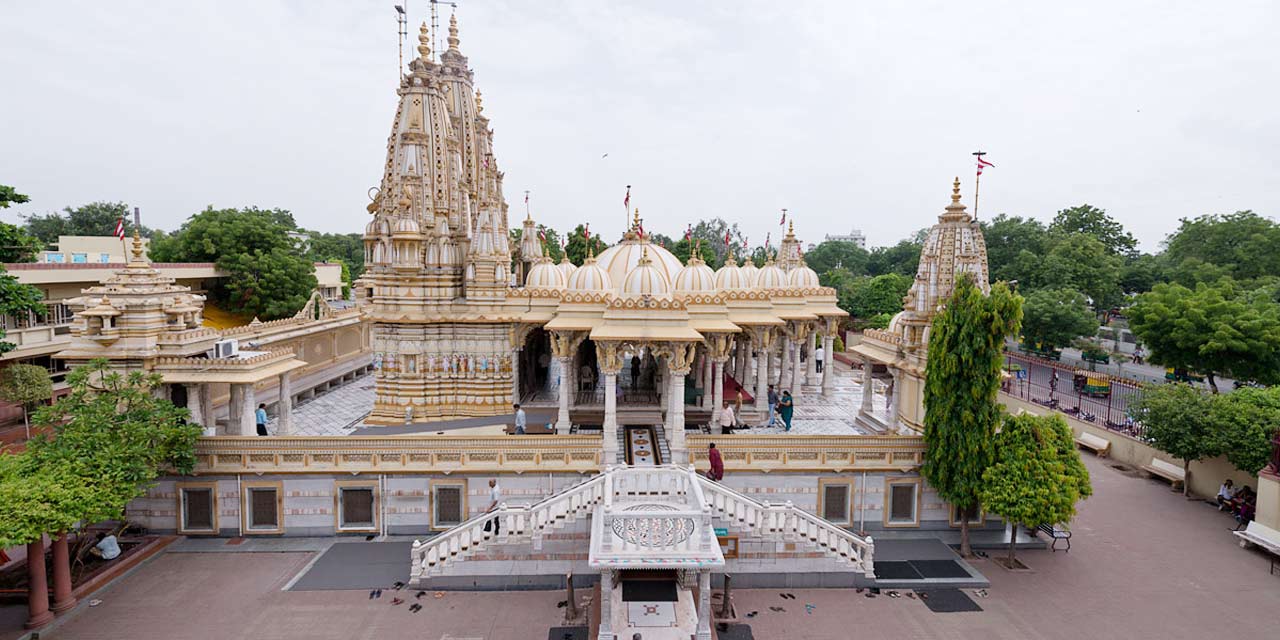Swaminarayan Mandir Ahmedabad Entry Fee
- No entry fee
Swaminarayan Mandir Ahmedabad Phone
079 2213 2170
Rating:  | 4/5 stars
| 4/5 stars
Based on total 45 reviews
Swaminarayan Mandir Ahmedabad Address: Kalupur, Ahmedabad, Gujarat, 380001, India
Ahmedabad’s striking architectural and religious sites are evidence of Hindu, Muslim and Jainism beliefs. Set at the banks of the Sabarmati River, the city of Amdavad proffers a plethora of archaeological sites that stand as a reminder of the Indo-Saracenic style of architecture.
Visitors would admire the grandeur of the sculptures of the historical monuments that have been inspired from mythical creatures. One of the fascinating temples of the city is the revered Swaminarayan Temple. While there are several temples in the city, this is an important holy place as it was the earliest temples of the sect and the headquarters of the NarNarayan Dev Gadi, an administrative division of the Swaminarayan Sampraday.
Swaminarayan Sampraday is a Hindu sect that is based on Vishishtadvaita, the most prominent form of schools of Hindu philosophy. Swaminarayan temple of Kalupur is one of the most highly revered and significant sacred shrine for the members of this sect. Richly decorated temple draws several tourists to admire the intricate beauty of the carvings and experience its ethereal atmosphere. Heritage walk starts from the renowned temple.
History of Swaminarayan Mandir
Swaminarayan Temple of Kalupur is the earliest of the temples built by the Swaminarayan Sampraday in 1822. Swaminarayan had built five more temples in other parts of the state and installed the images of the deities in these temples.
Swaminarayan Sampraday is categorized into two sections namely the NarNarayan Dev Gadi and the LakshmiNarayan Dev Gadi. While NarNarayan Dev Gadi or Uttar Vibhag covers the administrative works of the Northern Division, LakshmiNarayan Dev Gadi or Dakshin Vibhag caters to the administrative works of the southern division. Swaminarayan Temple at Kalupur serves as the headquarters of the NarNarayan Dev Gadi.
Swaminarayan planned to build the first temple of their sect and entrusted the task to a great saint Ananandanand Swamy, who was a paramhansa and a strong follower of Swaminarayan. Land for establishing the sacred complex was granted by the then ruling British Government.
As the British government wanted to build a railway station in Kalupur, the temple authorities returned a part of the land and in return received 1000 acres of land in Narayan Nagar Village. The temple was built on 5000 acres of land.
Swaminarayan
An eminent spiritual leader Swaminarayan was born in Uttarpradesh as Ghanshyam Pande who journeyed through various parts of India and some parts of Nepal for attaining the knowledge of Hindu philosophies at a young age of 11 years.
During his sacred journey for around 9 years he was actively involved in several welfare activities. In 1799 he moved to Gujarat where he stayed under the divine guidance of his guru Swami Ramanand and joined the Uddhav Sampraday.
He was then christened as Sahajanand Swami and was granted the responsibility of the Uddhav Sampraday in 1802 by his guru. He preached the Swaminarayan Mahamantra and thus the name of the sect was changed to Swaminarayan Sampraday and since then he became popular as Swaminarayan.
He had built around six temples and spread his philosophy by assigning the task to 500 spiritual leaders called Parmahansas. He taught his followers to lead a life devoid of immortality. Ahmedabad’s Swaminarayan Temple located at Kalupur was the first temple to be built by him.
There were around 1.8 million followers of the sacred sect at the time of Swaminarayan’s death. Swaminarayan had spent 30 years of his life in Gujarat spreading his teachings on Dharma.
Image Gallery of Swaminarayan Mandir Ahmedabad
Architecture of Swaminarayan Mandir
Known for its architectural splendour, Swaminarayan Temple of Kalupur enshrines Sri NarNarayan Dev. NarNarayan refers to the appearance of Lord Vishnu as twin brothers for restoration of Dharma. The Swaminarayan sect believes that Nar Narayan Dev was the prime controller of human being’s destiny and that Swaminarayan resided within the idol of NarNarayan Dev in Swaminarayan temple at Kalupur.
Visitors would be enthralled to enter the premises of the temple through a wonderful gateway that features a combination of Gujarati, Marathi, Rajasthani and British style of designs. Interesting sculptures of the gateway portrays Rajasthani and Marathi culture and the images of Gujarati women clad in local dress with their child held by them on their waist.
Upper part of the pavilions exemplifies Mughal architecture. Elaborately decorated and colourful arches enhance the charm of the glorious temple. Sanctum Sanctorum has the image of Narayan Dev made of marble. The idol of Radhakrishna Dev is set on his right. To the left of the main deity are the images of Dharmdev, Bhakti Mata and Harikrishna.
Akshar bhavan accommodates the beautiful image of Ghanshyam Maharaj in child form. Shree Tejendra Bhuvan the southern part of this bhavan provides shelter to the visiting devotees. Personal items used by Swaminarayan have been displayed on the ground and the first floor.
Rang Mahal, where Swaminarayan used to stay during his visits to Ahmedabad, houses the striking image of the Ghanshyam Maharaj. A notable feature added to Ranga Mahol after fifty years of its construction is the huge idol of Swaminarayan in a standing position.
Swaminarayan temple is an awe-inspiring sacred place of worship especially for the followers of the Swaminarayan sect that is made of Burma Teak wood. It is adorned with brilliantly ornamented domes and galleries. Travellers would marvel at the towering nine tombs known as Nau Gaz Pir or Nine Yard Saints located on the southern part of the temple.
An astonishing architectural site houses the deities covered with a majestic set of colourful attire and jewellery. This is a historic temple embellished with vividly painted brackets and features impressive craftsmanship. A sacred complex that reflects remarkable craftsmanship attracted a British official Sir Dunlop so much that he had ordered for a 101 gun salute in its honour.
Haveli
Next to the revered temple we have the old mansion or the haveli which used to be the official abode of Acharya of the NarNarayan Dev Gadi. A beautiful image of Ghanshyam Maharaj is housed in the haveli where the ground floor is now used as a sacred place of worship by the Samkhya Yogi women.
It also provides the accommodation for the pilgrims. Religious ceremonies and preaching sessions are held in the Haveli by the wife of the Acharya Maharaji and the spiritual leader of the women known as Gadiwalla Sankh Yogi
Women refers to the women of the sect who have taken a vow of celibacy as a form of respect. Swaminarayan supported women education and was against the practises of Sati. Beautiful chandeliers, huge mirrors, lamps and the brackets of the arches and pillars ornamented with geometrical designs add to the charisma of the haveli.
To the south of the temple, Acharya Maharajshree Keshav Prasad Ji Maharaj established a three storied mansion that attracts the attention of the visitors. It houses a sabha mandap supported with sixty pillars. Built in 1871, the mansion has varied stunning sculptures depicting Lord Hanuman flying with the Devgiri Mountain in his palm, Lord Ganesha with a turban on his head, army soldiers with a Marathi turban and herds of monkeys.
Sculptures also portray the 1857 uprising and other historic events like the fights of a Maratha warrior and Tantia Tope in the disguise of Narasimha. Panels of the building are decorated with beautiful floral motifs. Acharya sits in this mansion on a wooden seat once used by Swaminarayan in the congregation hall.
Heritage Walk
Municipal Corporation of Ahmedabad organises the heritage walk of Ahmedabad that covers around 1.5 kms to be covered in 3 hours. A historic voyage that starts at the auspicious Swaminarayan temple navigates through 20 historic sites before calling it off at the Jama Masjid.
Heritage Walk was started on 19th November 1997 by the Ahmedabad Municipal Corporation, AMC in coordination with an NGO named, the Foundation for Conservation and Research of Urban Traditional Architecture (CRUTA). Also popular as the journey of Mandir to Masjid, it introduces tourists to the rich culture, history and tradition of the 600 years old city.
Events and Festivals at Swaminarayan Mandir
Shree NarNarayan Dev Jayanti, Hindola Utsav, Shree Krishna Jayanti, Rushi Panchami, Dhanurmas, Phooldolotsav and Guru Purnima. Other festivals like Ganesh Chaturthi, Diwali, Maha Shivratri and Uttrayan are also celebrated.
How to Reach Swaminarayan Mandir
The temple is located in the eastern part of the old city near Kalupur. Ahmedabad is well connected through railways, airways and roadways. Lot of taxis, cabs and auto rickshaws are available from the railway station, bus stand and airport to the temple.
By Road: State government and private buses run from various cities and towns. Major bus stops of the city are Gita Mandir and Paldi. Book a cab from top car rental companies in Ahmedabad to easily reach the place.
By Air: Sardar Vallabhai Patel airport has both domestic and international flight connections.
By Rail: The nearest railway station is Kalupur Railway Station.
Dress Code
You are expected to visit the site with due respect and shoes must be taken off before entering the temple premises.
Entry Fees and Timings of Swaminarayan Mandir
There is no Entry fee to visit the temple.
The temple is open from 6:00 am to 7:00 pm for the visitors. Darshan is closed from 10.15AM to 11.15AM and 6.15PM to 7PM as it is the time of Bhog.
Morning Prayer: Several devotees attend the Morning Prayer service which connects them to divinity. Different artist or the ritual form of offering with lighted lamps is done as per below schedule:
Mangla Aarti – 5.30 AM
Shankar - 8.05 AM
Rajbhog - 10.10 AM
Sandhya – 7.00 PM
Shayan – 8.00 PM
Other Facilities: Multi-storeyed guesthouse and a medical clinic
Camera Fees: Photography is not allowed in the premises
Other attractions near Swaminarayan Temple
Teen Darwaza, Sidi Sayed Mosque and Jama Masjid
FAQs and Information on Swaminarayan Mandir
Ahmedabad is one of the most beautiful cities in Gujarat. It is known for its stunning architecture, rich culture and great food. If you are planning for a holiday to this gorgeous city, book an Ahmedabad tour package from us. We at Ahmedabad Tourism, a division of Holidays DNA, will guide you through the famous sightseeing places of Ahmedabad and help you plan your perfect vacation here. Our friendly staff will assist you during your stay in the city. Reach us by filling the Contact Us form. We will get back to you!





